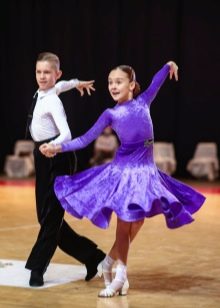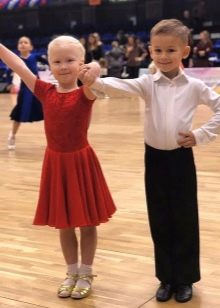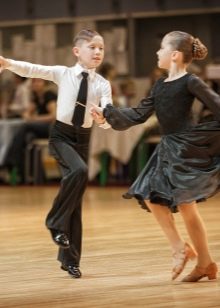All About Ballroom Dance Dresses
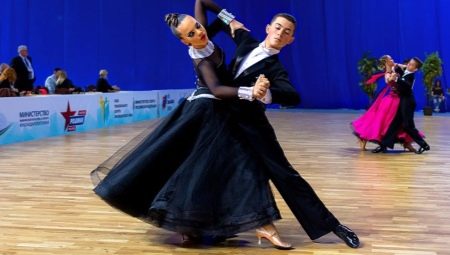
Dancing has been a favorite pastime of people of all ages since ancient times. Over time, different styles and trends have emerged that can now be mastered at any level. Sports ballroom dancing is a combination of beauty and harmony with hard work. For comfortable classes in the gym, girls need to wear comfortable and practical clothes, but at contests and competitions they must wear beautiful ball gowns. There are different types of dresses for different ages and dance styles.
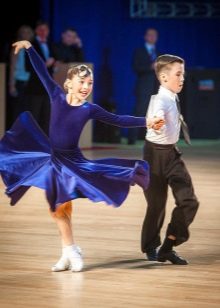
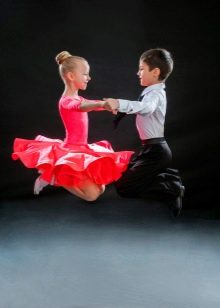
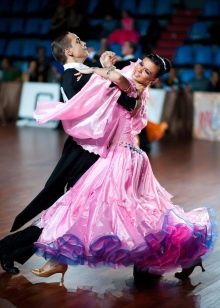
Species overview
Ballroom dancing requires specialized footwear and suitable clothing. Boys have shoes, black pants and a white top. Girls in training can use high or low heels as desired, a blouse with a skirt or a one-piece dress. An important feature of workout clothing is its comfort. Coaches do not focus on what children should wear, the main thing is that they feel comfortable.
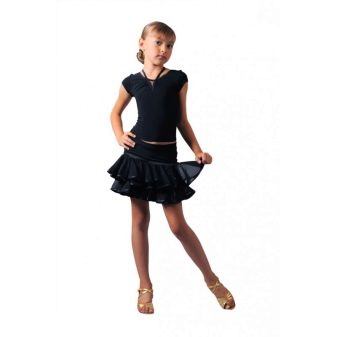

Completely different requirements for competition attire. There are certain criteria based on which children can use certain dresses. For girls there is an opportunity to choose long and short outfits, with or without decor, boys look about the same, using pants and shirts of different cut.
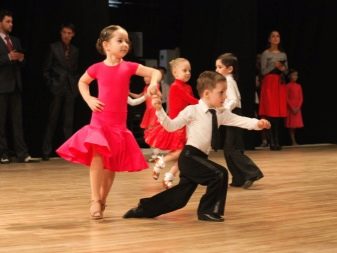

When planning the purchase or sewing of a dress for sports dancing, you must clearly navigate the existing rules. Among the variety of costumes, the following categories can be distinguished:
- standard;
- Latin American;
- rating;
- stage;
- training.
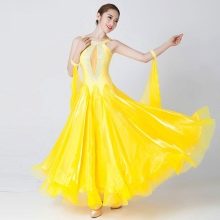

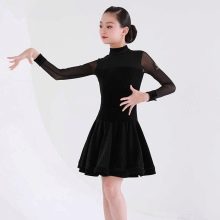
Each type has its own characteristics of tailoring, style and decor, so it is necessary to choose the right outfit, otherwise the dancer may not be allowed or removed from the performance.
Standard
Dance dresses that are worn to perform dances such as waltz, foxtrot, tango. A distinctive feature is the elongated skirt that reaches the shins or ankles... In modern versions, the length of the skirt can be shorter, but it should cover the knees. The cut of the bottom has a strong flare, which allows the skirt to flow and flutter as you dance. To make the outfit look advantageous, it is recommended to use several layers of material on the skirt.
A fitted top allows for a more figure-based contrast with a voluminous bottom. Sleeves may be short, long, or missing, and long gloves may be worn on the arms.
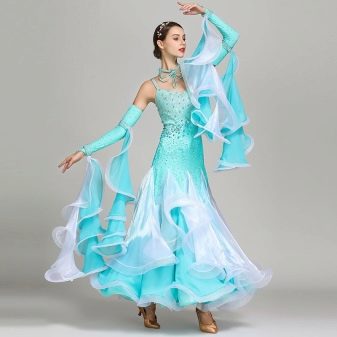
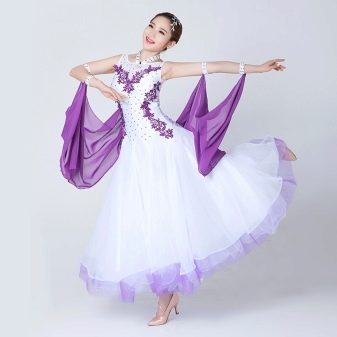
You can use standard dresses in categories «Juniors 2», «Young people», «Adults» and «Seniors». Sew-on and glue rhinestones, fringes, sequins, feathers can be used as decor. Their number is not limited, but you should not use too many decorative elements, since the standard outfit should be delicate, not catchy.
Dresses for the standard can be sewn from supplex, lycra, knitted fabric, oil, velveteen and other materials with good stretch. It is recommended to create a skirt from light flowing fabrics that will not interfere with dancers and will create an attractive appearance of the entire costume. Most preferred materials will be satin, chiffon, crinoline and the like. By choosing the right style, color of the product, beautifully decorating it with decor, you can get a chic dress for the standard program.

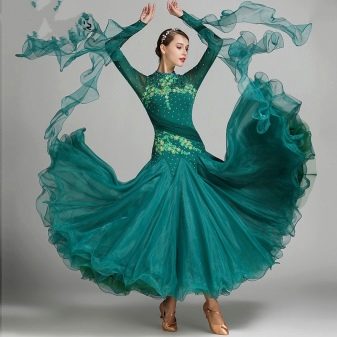
Latina
Tournament costumes for performing such dances as cha-cha-cha, samba, rumba, jive. The length of the dresses is usually short; the skirt can be multi-layered, have flounces or be complemented with fringes. The back can be made open or closed, which is dictated by the category of the dancer and the style of the outfit.
Such dresses can be used by dancers in the categories "Juniors 2", "Youth", "Adults", "Seniors".
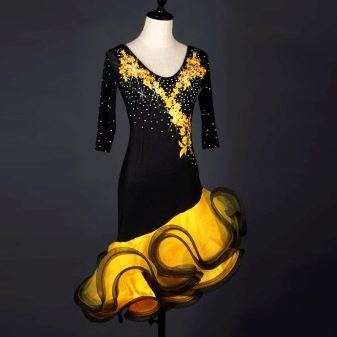
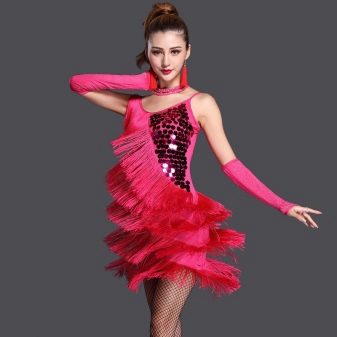
For latin, bright colors of fabrics and the presence of a large number of decorative elements are suitable. For sewing, you can use mesh, supplex or lycra, which have excellent stretch characteristics, which allows you to make any active movements during a performance. The advantage of such a material is the brightness of the shades, the presence of shiny and matte varieties, as well as sprayed fabrics, which add zest and make the girl irresistible on the set.
Sew-on rhinestones and asymmetric mirror stones, glue rhinestones, sequins, fringes are used as decoration. Latin American dances are notable for their incendiaryness, therefore, quite a lot of bright and brilliant elements can be used in them.
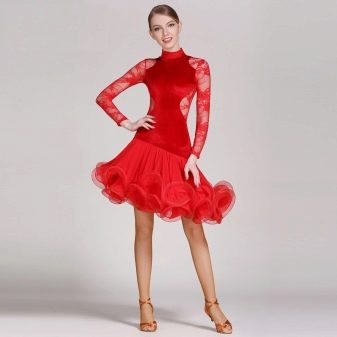
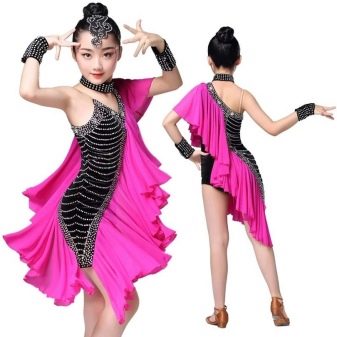
Rating
A rating suit or basic is the most simple outfit without additional decor. Such dresses are used in the categories "Children" and "Juniors 1". Children's dresses can be sewn from supplex or lycra, stretch velor can be used. The main feature is the use of only one shade of fabric. The costume consists of a long-sleeved leotard and a knee-length skirt sewn on top.
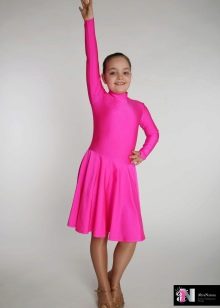
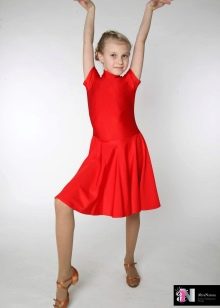
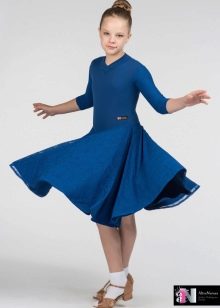
Guipure can be used to decorate the outfit, but its shade must match the color of the entire product, and it must be sewn onto the fabric.... In the junior category, mesh elements or the use of bodily material are unacceptable. Rating dresses are used for all dances of the program, girls and boys do not change clothes during the competition, as older dancers do.
Despite its strict limitations, the basic can look very beautiful and stylish if its cut is in line with the figure. To make the outfit look advantageous, you need to choose a shade based on the color of the child's skin and hair.
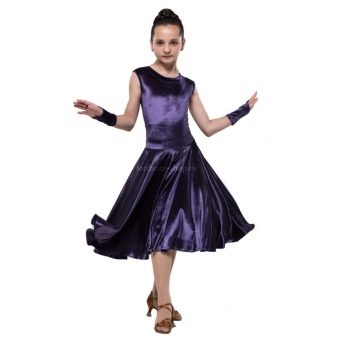
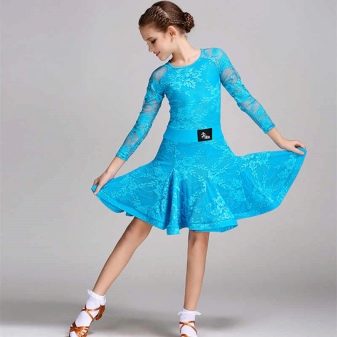
Stage
Stage costumes are a special category. These outfits do not have any special restrictions, they are sewn for a specific dance or number. Dancers of any age group can use stage dresses outside of the competition program. For demonstration performances and specialized performances that are not evaluated by the judges, you can use any fabrics, colors, use the right amount of decorative elements. The main task of such costumes is to convey the mood of the dance, complement it.
The length of the skirt, its cut and materials can be very diverse. The top of the dress can be closed or open, the length and style of the sleeves are also not regulated.
Thanks to this freedom in actions, seamstresses can create very beautiful outfits for demonstration performances, and dancers can fully enjoy the dance, reincarnating in a given image.

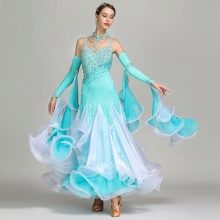
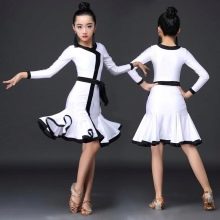
Training
In addition to competitions and performances, dancers also have training, which they should devote maximum time and effort to in order to achieve good results in tournaments. Ballroom dancing requires physical strength, endurance, flexibility and coordination. To develop all these qualities, athletes train systematically, honing their skills.
To make the training process as comfortable as possible, children need comfortable clothes that will not distract attention, interfere and cause discomfort. Boys can train in comfortable trousers and a T-shirt, girls can use leotards and a skirt, a blouse or T-shirt and breeches, knee-highs and leggings.
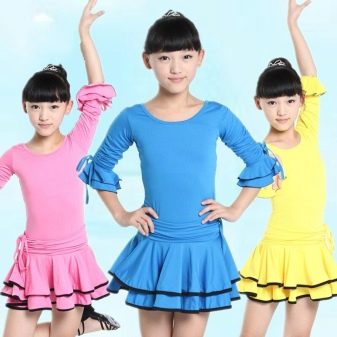
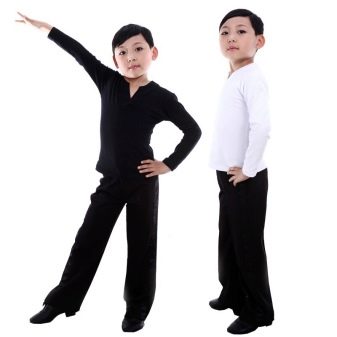
Focusing on the season, the temperature in the hall and the dancer's desire, you can choose different tracksuits... The most suitable material for daily activities is a cooler or jersey. Natural canvas, which absorbs moisture well and allows air to pass through, will allow you to work hard for a long time.
The colors of the training outfit may vary depending on the dancers' preference. It is recommended to use neutral shades that do not distract children during the lesson: black, gray, brown, dark blue, dark green. A properly chosen training suit will allow you to work efficiently and reach the set heights.
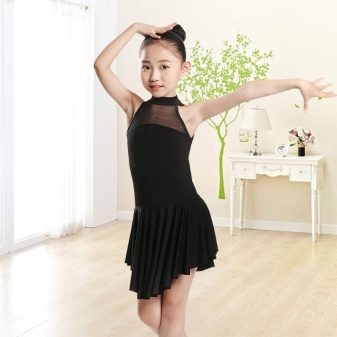
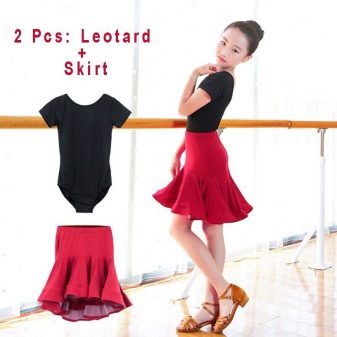
Variety of styles
Dresses for sports ballroom dancing have a different appearance, due to which each athlete looks original, stylish and beautiful. Costumes for children and adults differ significantly due to the existence of clear rules. Each program has its own styles that emphasize the dignity of the girls and complement the overall image of the couple.
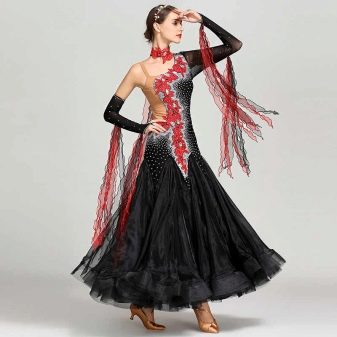
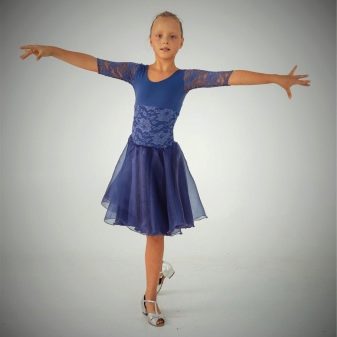
For the standard program, you can use the skirt cut:
- year;
- half sun;
- flared sun;
- asymmetry.
The top of the dress is fitted, the sleeves are usually long.

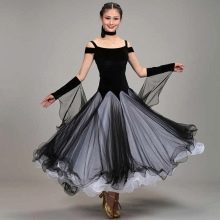
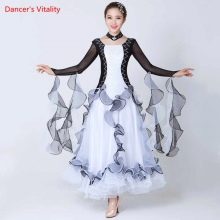
Suits for Latin American dresses are characterized by their variability, there can be many styles that differ:
- the length and shape of the skirt;
- we cover the upper part;
- the presence or absence of sleeves;
- the presence of additional decorative elements in the form of wrist bracelets.

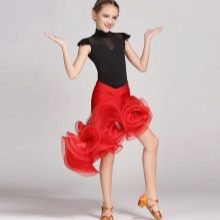
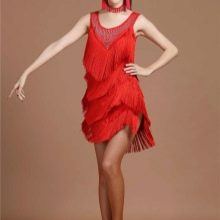
The back in such dresses can be as open or completely closed, the sides can also be open or closed. The length of the skirt varies depending on the height of the athlete or her wishes.
According to the style, the skirt can be tight-fitting with an asymmetrical bottom, have an even edge, but a voluminous structure, complemented by decorations in the form of a fringe or bugle.
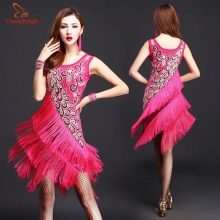
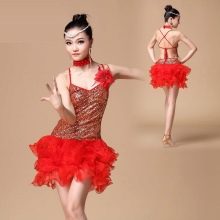
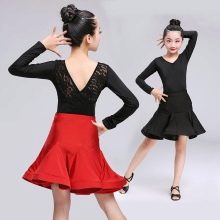
The basic style is as simple as possible, it is a leotard with long sleeves and a knee-length skirt. The skirt can be placed just above the waistline or slightly understated. The bottom part can be flat or have small flounces. As a decoration, guipure is used in the color of the suit, sewing it onto the base of the product.
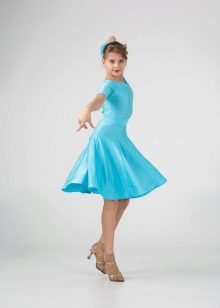
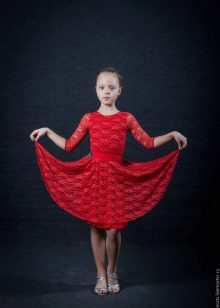
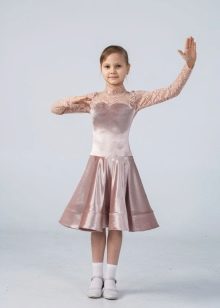
Beautiful ballroom dresses, made in accordance with the rules of this sport, allow you to emphasize the figure and create a unique image.
Color palette
Any color can be selected for sewing dance dresses. There are restrictions only on the use of several colors in the junior categories, the rest of the suits can have any design.
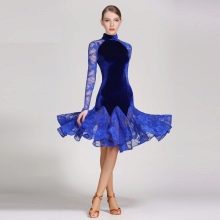
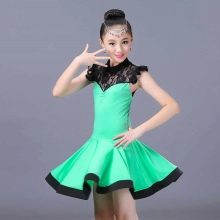
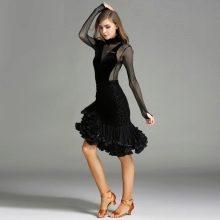
The choice of colors is carried out depending on the color of the girl's skin and hair... Blondes with fair skin are best suited for green and blue shades. Bright fabric options will overlap the child himself, which is disadvantageous for competition. Brunettes should choose green, blue, scarlet, gold colors of outfits. For girls with dark skin, a white dress is best. Black options will look less advantageous, so choose this color with caution.
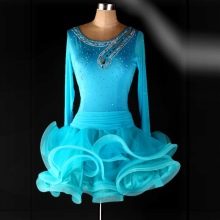
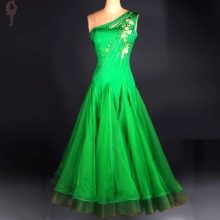
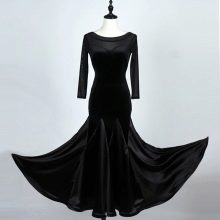
The most versatile and popular is the red shade of ballroom dance dresses. It is very important not to blend in with other members in an outfit of the same color scheme. Therefore, it is worth taking care of creating a unique cut and style so that the dress stands out on the dance floor.
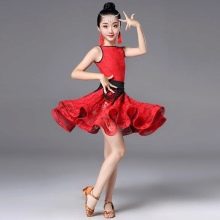
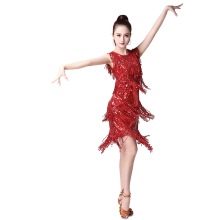

Criterias of choice
When choosing a ball gown, it is necessary to take into account several important nuances.
- The category in which the girl performs. The lower the category, the more restrictions.
- Height, skin and hair color of the child... Based on these criteria, the color of the dress and the style are selected.
- Selection of fabric. For the convenience of the girl during dancing, the material should be stretchy, breathable and absorb moisture.
- Costume decor... Each category has its own clear rules for what can be used. The choice of acceptable decorations is made based on the wishes and capabilities of the dancers' parents.
- Choosing the right counselor... If you have any questions regarding the dress for the performance, you should ask the coach for advice. It is he who has sufficient knowledge, qualifications and experience to give good advice and find the best solution.
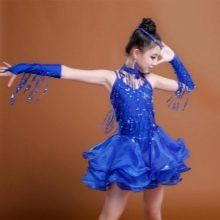
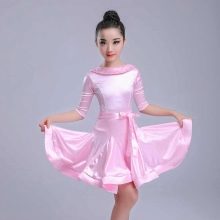
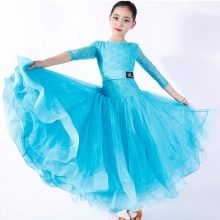
A couple's success largely depends on their technical background, musicality and emotionality, but with a beautiful and appropriate dress, better results can be achieved during a performance.
